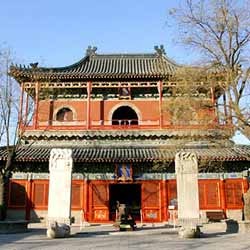
Main attractions
The oldest music in Beijing originating over 500 years ago, soothes the soul as you enter this temple-turned museum. The Jing music in the temple was listed as one of China's national Oral & Non-Material Heritages this month.
The temple was built in 1444 by Wang Zhen, a eunuch in the Ming Dynasty, who, in charge of protocol and ceremonies in the Forbidden City, spirited court music scores out to his family temple. His thieving helped preserve the ancient music, a combination of court and Buddhist music, to the present day, as monks in the temple passed down the music from generation to generation.
The temple itself is full of historical interest with its black-glazed-tile ceiling, an eight-piece wooden architecture complex (rare in Beijing), and the exquisitely carved nice-level octagonal cupboards, each with five drawers for storing Buddhist scriptures. The cupboard is the oldest in Beijing, much older than those on show at the Summer Palace and the Yonghe Lamasery.
Besides the temple itself there are currently two temporary exhibitions, one displaying Buddhist images, the other a collection of ebony sculptures by an artist from Sichuan Province.
Eye catchers
The museum's architecture is beautiful, its layout spacious and is brought to life by the pear flowers on the trees in spring.
But the real joy is the music, performed four times a day (9, 10, 11 AM, 3 PM) by devotees, who learned to play the hard scores from the last resident monk, Zhang Benxing, who is now over 80.
Child-friendly activities include regular tie-dye cloth classes, and the rubbing of music score inscriptions from stone tablets. There is more fun to be had climbing the steep wooden stairs to the museum's highest point -- Wan Fo Ge (Ten Thousand Buddhas Tower), to get a great view of the hotchpotch architecture of modern Beijing.
In the Great Mercy Hall ancient musical instruments are on display and are close enough for you to touch, in fact visitors are encouraged to do so. There is also a touch-screen computer, with which you can choose to listen to different Jing works.
Digital audio tour guides can be rented for five yuan (with ID and 100 yuan as deposit). Besides Chinese, there are six languages to choose from: English, French, German, Japanese, Korean, and Spanish.
Pity
Some of the beautifully carved sunk panels on the ceilings were pulled down for sale overseas in 1930, and are now kept in a museum in the USA.
Add: No.5, Lumicang Hutong, Dongcheng District.
Entry ticket: 20 yuan for adults, 10 yuan for students with ID card.
Opening time: 9 AM -- 4:30 PM (except Monday)
Traffic: Take Bus No.713 to get off at Lumicang, head south to enter Lumicang Hutong to go eastward, or take Bus No.s 44, 750, 800, 810, 820 or T2 to get off at Yabaolu, take Jinbaojie Street, then turn right (north) to enter Xiaopaifang Hutong, then left to Lumicang.
Tel: 86-10-6528-6691.
(China Daily January 28, 2006)
|

